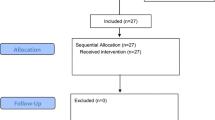Abstract
Purpose
Loss of motor response to thrusting the jaw forward is a useful indicator for uncomplicated insertion of a supraglottic airway. The aim of this study was to assess the suitability of remimazolam for insertion of a supraglottic airway assessed by loss of response to jaw thrusting.
Methods
Seventy patients, who were scheduled for elective surgeries under general anesthesia, were allocated randomly to one of two groups. In one group (remimazolam group), remimazolam was infused 12 mg kg−1 h−1 (50 mg maximum), and in the other (propofol group), propofol was infused at 120 mg kg−1 h−1 (500 mg maximum). Once the eyelash reflex disappeared, response to jaw thrusting was assessed. Primary outcome measure was the proportion of patients with loss of response to jaw thrusting before reaching the maximum dose of the test drug. We planned an interim analysis (of one time) after 40 patients, using the Pocock adjustment method.
Results
From the interim analysis results, the study was stopped after recruitment of 40 patients. Loss of response to jaw thrusting was observed in all of 21 patients (100%) in the propofol group, and in 9 of 19 patients (47%) in the remimazolam group. There was a significant difference in the proportion between the groups (P = 0.0001, 95% CI for difference 30–75%).
Conclusion
Remimazolam frequently does not inhibit response to jaw thrusting, and thus remimazolam is not a suitable induction agent for uncomplicated insertion of a supraglottic airway unless either a neuromuscular blocking agent or an opioid is co-administered.



Similar content being viewed by others
Data availability
The data are available from the author.
References
Doi M, Morita K, Takeda J, Sakamoto A, Yamakage M, Suzuki T. Efficacy and safety of remimazolam versus propofol for general anesthesia: a multicenter, single-blind, randomized, parallel-propofol grouphase IIb/III trial. J Anesth. 2020;34:543–53.
Doi M, Hirata N, Suzuki T, Morisaki H, Morimatsu H, Sakamoto A. Safety and efficacy of remimazolam in induction and maintenance of general anesthesia in high-risk surgical patients (ASA Class III): results of a multicenter, randomized, double-blind, parallel-group comparative trial. J Anesth. 2020;34:491–501.
Chae D, Kim HC, Song Y, Choi YS, Han DW. Pharmacodynamic analysis of intravenous bolus remimazolam for loss of consciousness in patients undergoing general anesthesia: a randomized, prospective, double-blind study. Br J Anaesth. 2022;129:49–57.
Sneyd JR, Gambus PL, Rigby-Jones AE. Current status of perioperative hypnotics, role of benzodiazepines, and the case for remimazolam: a narrative review. Br J Anaesth. 2021;127:41–55.
Asai T, Morris S. The laryngeal mask airway: its features, effects and role. Can J Anesth. 1994;41:930–60.
Drage MP, Nunez J, Vaughan RS, Asai T. Jaw thrusting as a clinical test to assess the adequate depth of anaesthesia for insertion of the laryngeal mask. Anaesthesia. 1996;51:1167–70.
Tan CH, Onsiong MK. Pain on injection of propofol. Anaesthesia. 1998;53:468–76.
Kanda Y. Investigation of the freely available easy-to-use software ‘EZR’ for medical statistics. Bone Marrow Transplant. 2013;48:452–8.
Altman DG. Practical statistics for medical research. London, UK: Chapman and Hall; 1991.
Pocock SJ. Interim analyses for randomized clinical-trials—the group sequential approach. Biometrics. 1982;38:153–62.
McKeating K, Bali IM, Dundee JW. The effects of thiopentone and propofol on upper airway integrity. Anaesthesia. 1988;43:638–40.
Rex MAE. A review of the structural and functional basis of laryngospasm and a discussion of the nerve pathways involved in the reflex and its clinical significance in man and animals. Br J Anaesth. 1970;42:891–9.
Alalami AA, Ayoub CM, Baraka AS. Laryngospasm: review of different prevention and treatment modalities. Paediatr Anaesth. 2008;18:281–8.
Shirozu K, Nobukuni K, Tsumura S, Imura K, Nakashima K, Takamori S, Higashi M, Yamaura K. Neurological sedative indicators during general anesthesia with remimazolam. J Anesth. 2022;36:194–200.
Stoneham MD, Bree SE, Sneyd JR. Facilitation of laryngeal mask insertion: effects of lignocaine given intravenously before induction with propofol. Anaesthesia. 1995;50:464–6.
Doi M. Remimazolam. Nihon Rhinsho-masui Gakkaishi. J Japan Soc Clin Anesth. 2014;34:860–6.
Acknowledgements
We thank the staff of the Department of Anesthesiology, Dokkyo Medical University Saitama Medical Center, for their contribution to this study.
Funding
This study was funded by Research Incentive Grant of Dokkyo Medical University [Grant numbers: 2280].
Author information
Authors and Affiliations
Contributions
HA: This author helped in the study conception and design, proposal writing, data collection, data management and analysis, data interpretation, as well as drafting and approving the final version of the manuscript. TA: This author helped in the study conception and design, proposal writing, data management and analysis, data interpretation, as well as drafting and approving the final version of the manuscript. TS: This author helped in the study conception and design, proposal writing, procurement of study drugs, as well as revising and approving the final version of the manuscript. YO: This author helped in the study design, proposal writing, as well as revising and approving the final version of the manuscript.
Corresponding author
Ethics declarations
Conflict of interest
HA, TS, and YO have no conflict of interest; TA is an Associate Editor-in-Chief of the Journal of Anesthesia.
Additional information
Publisher's Note
Springer Nature remains neutral with regard to jurisdictional claims in published maps and institutional affiliations.
About this article
Cite this article
Arime, H., Asai, T., Saito, T. et al. Remimazolam: a randomized controlled study of its suitability for insertion of a supraglottic airway. J Anesth 37, 762–768 (2023). https://doi.org/10.1007/s00540-023-03231-2
Received:
Accepted:
Published:
Issue Date:
DOI: https://doi.org/10.1007/s00540-023-03231-2




